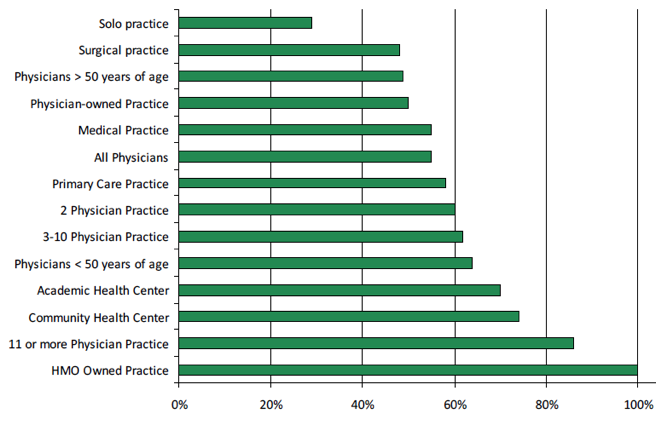There is a lot of excitement this week, both in my home state of Virginia and along the Eastern seaboard as people prepare for a storm named Sandy. Forecasters are describing a confluence of events which could turn this category 1 hurricane into a something that rivals the storm of 1991. That storm wreaked havoc in the Northeast and spawned a book and movie, which among other things has made me leery of deep-sea fishing expeditions. Of course, predictions are just that, forecasts based on underlying models that attempt to separate the Signal from the Noise.
In health IT, I think nephrology may have a similar storm brewing. The meaningful use program is about to conclude its second full year. It is no coincidence that EHR adoption has increased in concert with this CMS program. As recently noted by the CDC, EHR adoption rates are soaring, particularly among larger practices and younger physicians. In our experience, adoption rates among nephrologists are north of 75%. It should come as no surprise that our specialty is near the head of this class.
EHR Adoption Rates
Not unlike what has been forecast for Sandy, I see a confluence of factors ahead which may create a perfect storm for nephrologists. The rapid rate of adoption has been driven to some degree by the large financial incentives CMS has dangled in front of providers. The original intent of this incentive was to mitigate one of the barriers to adoption—the financial one. What we sometimes see in the market, however, is this incentive has become the goal, not a byproduct of adoption. Chasing the incentive establishes an unhealthy habit, particularly in an environment where the incentive declines as the hurdles rise.
Adding to this confluence of factors for nephrology is the intriguing role the dialysis encounter plays in the meaningful use framework. The “50% rule” has compelled most nephrologists to access their certified EHR from within the dialysis facility. While challenging, the Stage 1 objectives are readily obtainable in this paradigm. The Stage 2 objectives are another story. My early trip through the Stage 2 final rule suggests this approach may not be viable. Some will call for the dialysis organizations to certify their systems for meaningful use, and while this seems at first glance to be a tenable solution, upon closer inspection it is not so clear.
Dialysis facilities operate almost as a hybrid between a classic ambulatory practice and a hospital practice. This dichotomy creates some interesting challenges. Another factor fueling the storm ahead is the other side of the 50% rule. If more than half of your patient encounters occur in a venue of care where the decision to deploy a certified EHR is outside of your control, you are eligible for an exemption from the looming penalty, if that venue is not equipped with certified technology.
In an odd way, the phrase “perfect storm” conjures up a comedian of my youth. In a rare PG-13 routine, I still recall Mr. Carlin having fun with oxymorons like “jumbo shrimp” and “non-stop flight.” He would later go onto to establish a large number of such word pairs. What could be so perfect about a storm?
If you live along the Eastern seaboard and find yourself in Sandy’s path, I sincerely hope she treats you well. In a few short days we will look back and measure the accuracy of the forecasters’ predictions. The nephrology storm, however, will take a couple of years to come to fruition, leaving us with plenty of time to prepare. In the meantime, keep the wind at your back.




Leave a Reply